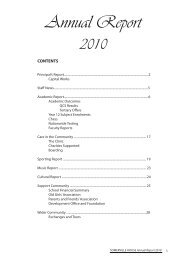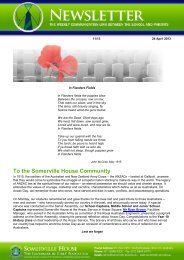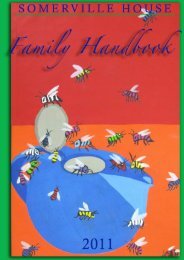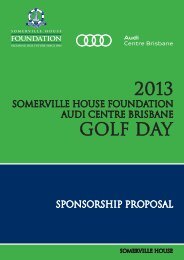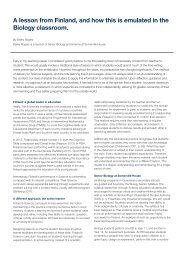Jamming with Dead Poets - Somerville House
Jamming with Dead Poets - Somerville House
Jamming with Dead Poets - Somerville House
- No tags were found...
You also want an ePaper? Increase the reach of your titles
YUMPU automatically turns print PDFs into web optimized ePapers that Google loves.
The Romantic act of declaring against; the ‘against-ness’ and‘outsideness’ and ‘victimage’ (Fleming & O’Carroll, 2005) of Romanticpoetry, are appealing to students whose lives are frequently micromanaged,leaving little room for rebellion other than a bit of furtivetexting under the desk. Craig Schuftan, who traced the Romanticorigins of rock & roll in Hey Nietzsche! Leave Them Kids Alone!, sumsup Byron’s appeal on his blog: ‘Lord Byron was incredibly emo…Hewrote poems about pale, doomed young men brooding in crumblinggothic abbeys… and London, Paris and Berlin were soon infested<strong>with</strong> gloomy young men studiously imitating the poet’s funereal pallor,limping walk, and melancholy stare… He always said that he wasn’ta romantic – ostensibly because he felt he had more in common <strong>with</strong>Pope than Wordsworth – but mostly because he hated the idea of beingpart of a group. Which is, of course, about as Romantic as you can get’(Schuftan, 2010).We are careful not to conflate Romanticism and Victorianism, aproblematic term which can designate the historical period of QueenVictoria’s reign or a coherent cultural movement. Susan Wolfson (2001,1436) agues that, whereas the term ‘Romantic’ signifies a sensibility anda literary orientation, the term ‘Victorian’ is a co-ordinate to a monarch’sreign. She cautions against what she calls a ‘periodizing consciousness’which carves up literary periods into neat parcels of cultural and literaryhomogeneity. Such a consciousness is, she asserts, ‘self-legitimating’and grounded in cultural narratives of difference from, and reaction to,the past (Wolfson, 1434). This is particularly evident in Victorian textswhich either valorize difference from what has come before, or elegizethe past.Music has proven to be a brilliant way to ease the pain, and hopefullyfoster an enjoyment, of poetry too readily consigned to the ‘toohard’basket. The marriage of poetry and music is nothing new. TheMedieval minstrels and the bardic tradition, the troubadours of theMiddle Ages, German Lieder and the folk ballads of Britain and Europe,attest to a long and happy marriage of music and poetry. A poemwas an aural product, performed in a public context. Robert Albrecht(2010, 2) declares music as ‘a form of intelligence that helps us tomediate our emotional life, to construct a sense of self, and to organiseour inner being in a way not possible <strong>with</strong> mere words alone’. The‘presentational symbolism’ of song is somehow purer, more authenticand unadulterated than the ‘discursive symbolism’ of words-on-a-page,paralleling the ‘all-at-once gestalt of reality’, he argues (p.2).It wasn’t hard to find plenty of examples of modern musicalreincarnations of our favourite ‘dead poets’. We were surprised to seehow many contemporary musicians had been inspired by Coleridge’sRime of the Ancient Mariner and Blake’s Songs of Innocence andExperience. Bruce Dickinson, both as frontman for Iron Maiden andas a solo artist, has transformed Coleridge’s Romantic epic into anindulgently searing rock anthem, a heavy metal attempt to captureThe Sublime. The Cure wrote ‘Adonais’, inspired by Shelley’s poignantwords, ‘He hath awakened from the dream of life’. Students tendto cringe at Leonard Cohen’s ‘Go No More A-Roving’, and they findThe Fugs’ ‘Dover Beach’ very twee and ‘checked shirt’ folksy. TheLady of Shalott is always a popular choice of poem, its iambic meteraccentuated by Loreena McKennitt’s vocals. Other useful adaptationsinclude soprano Sarah Hillis’ ‘Kubla Khan’ and ‘She Walks in Beauty’ byNicholas Dodd and Sissel, from the soundtrack to the 2004 film VanityFair.William Blake’s writing and art have attracted a coterie of contemporaryliterary and musical admirers, including Allen Ginsberg, Van Morrison,Billy Bragg, Bruce Dickinson, The Fugs and Patti Smith, who in 2007published a Vintage Classics selection of his poetry. One of our mostuseful examples of the transformation of poem into song is the workof former bassist <strong>with</strong> Public Image Ltd, Jah Wobble. Wobble believesthat the visionary bite of Blake’s poetry can be reinvented brilliantly fortoday’s music audiences. Of Blake, Wobble says, ‘He’s been hijackedby retired colonels in Surrey who think he represents their Albion, and heabsolutely doesn’t’. Blake’s appeal is that he was critical of church andstate, a free-thinker and libertarian, and a printer living in penury or, asWobble puts it, ‘a London bloke who worked for a living’ (Trilling, 2009).Students find Wobble’s cockney vowels in Tyger Tyger amusing, theirstrangeness accentuating the assonance, rhyme and half-rhyme ofBlake’s lyric. In a review for Time Out, Peter Redmond writes thatWobble’s 'Lonely London' ‘uses Blake's own words to cast a jaundicedeye over our city, before segueing into a curiously, and perhapsconsciously, Lydonesque snarl through some of the mere colourful ofthe 'Proverbs of Hell’’. The ‘cockney mystic’s’ version of 'Auguries ofInnocence' is ‘a sulphurous, vituperative rant’ (Redmond, 1996):The LP works on several levels, like Blake's own work. On the onehand it's a perfectly good Jah Wobble piece, while on the otherit places him in the tradition of 'cockney mystics' to which Blakebelonged, according to Wobble's sleeve-notes, and asserts theredemptive qualities of innocent, unconditional love. Moreover, itmythologises place, layering city upon city, Zion upon Jerusalemupon Babylon. However, the bad news is that a similar exercisewas undertaken in 1980 by jazzer Mike Westbrook, whose 'BrightAs Fire' was a setting of Blake's texts distilled from a stagebiography. Still... chalk and cheese eh? Or, as Mr B put it, 'Foreverything that lives is holy, life delights in life'.The very idea that the man in a frockcoat and cravat might have beena free-loving revolutionary, a Georgian ‘punk’, is so unlikely as to beintriguing to students.Not only must our would-be journalists become attuned to the rhythmsof a Blakean lyric or an ode by Keats; they must also familiarisethemselves <strong>with</strong> the discourses and textual conventions associated<strong>with</strong> music reviews. According to sociomusicologist Simon Frith (quotedin Brennan, 19), music journalists are the ‘ideological gatekeepers’.The point of music journalism is not so much to represent the musicto the public, but to create a ‘knowing community, orchestrating acollusion between selected musicians and an equally select part ofthe public, select in its superiority to the ordinary, undiscriminating popconsumer’ (Frith 1996, quoted in Brennan, p.19). Music journalism isa performance or a dialogue between writer and reader. It is a ‘textualsystem’ – that is, it constructs readers as the knowing public; itconnects them to other systems such as those of politics, economicsand social control. (Hartley 1996, quoted in Brennan, 20).Music journalism is fascinating for its masculinisation of rock. KembrewMcLeod’s 2002 analysis of US album reviews over three decades(1971-1999) finds that throughout this period the writing ‘valorisesserious masculine “authentic” rock and dismisses trivial, feminine“prefabricated” pop music’ (McLeod 2001, quoted in Atton, 57). Hecontends that the ‘semantic dimensions’ of this rock criticism can befiled under the masculine (‘aggressive intensity’, ‘violence’, ‘rawness’,‘authenticity’, ‘seriousness’) and the feminine (‘softness’, ‘blandness’,‘vapidity’, ‘sweet sentimentalism’). This tendency is reinforced by AnnaFeigenbaum’s 2005 study of the press coverage of American singerAni Difranco, where adjectival gender markers are deployed to similarends. She finds that masculine markers typically denote excellence inmusicianship and musical influence; female markers refer, instead, tothe voice and body of the performer (quoted in Atton, 57).The music review, <strong>with</strong> its intended reader constructed as a memberof a privileged and discerning ‘knowing community’ (Frith quoted inShepherd, 2011, p.4), features the narrative tropes of authenticity,artistic credibility and nostalgia (Frith quoted in Shepherd, p.2). Rock isvalorized at the expense of pop music. The music which is consecratedis that which takes contemporary listeners back to the ‘grass roots’authenticity of the high priests, Led Zeppelin, The Who, Bob Dylan andJimi Hendrix. The reviewer honours readers’ discrimination and taste,conferring upon them membership of a select group which eschews thehome-brand banality and homogeneity of popular culture. Paradoxically,re-mastered ‘classic rock’ and new rock releases <strong>with</strong> ‘classic’ roots aregenuine, solid, enduring and, therefore, canonical.Students trace the evolution of music journalism. The ‘New Journalism’of the 1960s, also known as ‘literary journalism’, was introducedprimarily by Tom Wolfe, American author and journalist. It describedan emerging style of journalism which consciously adopted a literarytone and style, and focused on a subjective engagement <strong>with</strong> thesubject. We rummage through the online archives of Rolling Stone andinvestigate online journals such as Australia’s Mess & Noise (http://www.messandnoise.com/) and Pitchfork. We sample some of the colourfuland self-indulgent reviews published in Crawdaddy, Creem and RollingStone by, for example, the never-dull Lester Bangs, if we can source areview which isn’t too heavy <strong>with</strong> expletives.The righteous, evangelical tone of this writing can be anything fromamusing to tiresome to inspirational. For instance, Q journalist JohnHarris 2010, p.100) brands the music of Vampire Weekend as‘slam-dunk-ish’, causing the undeserving listener a ‘sharp pang ofambivalence’. He adds, loftily, that band members ‘still have a tendencyto sound rather pleased <strong>with</strong> themselves, all arched eyebrows and
memories of long afternoons in the college library’. Harris offersa confection of intertextual allusions and cultural references in hisevaluation of the album, Contra: ‘If we can all tune into noise fromacross the planet, what explains the continuing hegemony of whitebreadAmerican punk-pop, or the fact that so many young Britishmusicians want to sound like the lowest common denominator of aJohn Peel show circa 1983?’ (2010, p.100) In Uncut, a review of Yonderis the Clock by The Felice Brothers, an album inspired by Mark Twain’snovella, The Mysterious Stranger, measures the post - 9/11 relevanceof ‘Twain’s bitter rant’ and its suitability as the ‘allegorical landscape’of choice for the album. Reviewer Allan Jones (2009, p.74) writes ofthe ‘coarse manipulation of popular opinion by seeded minorities…and their submission to the will of the craven majority’; he lambaststhe ‘servile obedience, hypocritical acquiescence and self-servingspinelessness’ represented in Twain’s story, endorsing its transformationinto song by The Felice Brothers, themselves ‘no strangers to the rawhurt of things, the desperate scrabbling of the bereft and oppressed,life’s losers pinned to a wheel of pain’. Josh Eells writes in Rolling Stone(2011) of the latest Cold Play album: “Mylo Xyloto suggests [ChrisMartin has] fully embraced his role as a not-terribly-cool guy who’sgood at preaching perseverance, in a voice that’s warm and milky likeafternoon tea’. Irresistibly, it is a ‘bear-hug record for a bear-marketworld’, <strong>with</strong> a ‘sproingy New Wave beat’.This is highly figurative, muscular writing. While it can be smug andcloudy <strong>with</strong> logic-defying metaphor, this writing is instructive in its useof persuasive language. Students identify the textual features of simileand metaphor, hyperbole and understatement, compound words,neologisms and rhetorical devices such as anaphora and antithesis.They consider the use of nominalisation to package ideas and toestablish an authoritative tone, and the way modality can be altered toposition readers. The danger is, of course, that students will overwriteand embroider when they play <strong>with</strong> language, producing reviews whichare florid and full of torturous mixed metaphors and tautology. Studentsclearly require a lot of support and scaffolding resources in the earlystages of the unit. We neither presume that they have an extensivemusical vocabulary, nor do we expect that, <strong>with</strong> the exception of Musicstudents, they have written evaluatively and analytically about music.We help them to build a suitable lexicon of music terminology andjournalese by reading, discussing and dissecting published reviews. Iftime permits, we invite a local journalist to share some tricks of the trade<strong>with</strong> us.Students’ responses to the task have been impressive. Some, as wewould expect, found the multiple demands of the review overwhelming.They had difficulty staying focused on the poem as a performance insong, instead writing a conventional poetry analysis. Others dazzledreaders <strong>with</strong> an outpouring of music jargon, giving insufficient attentionto the complexities of the poem.Kirby chose to imagine that Australian band Closure in Moscow hasdiscovered Blake’s poetry:The lyrics to this track were written in the midst of the IndustrialRevolution. Audible are Blake’s strong views on the ‘dark Satanicmills’ and their influence not only on ‘England’s green andpleasant land’, but on the religious conscience of a nation intentupon creating these incarnations of the Devil. The band flirts <strong>with</strong>the ‘evil’ Locrian mode, and this risky move will surely draw theattention of music Mussolinis world wide.… The song emphasises the natural beauty of England: the‘mountains green’, the ‘pleasant pastures’. Plosives are usedhere to add to the feeling of purity and gentleness. Furthermore,Christ is described as ‘the holy lamb of God’ and this imageof fertility and innocence augments the depiction of the naturallandscape. The audience is now set up for the blast of an in-yourfacejuxtaposition <strong>with</strong> the ‘clouded hills’ of England, hazy notonly <strong>with</strong> smoke from the mills, but <strong>with</strong> the pollution of immoralityand sacrilege, not to mention the ambiguity of suspensions andoctaves from the bass.Keilin reviewed a version of Keats’ Ode to a Nightingale sung by Englishsinger-songwriter, Adele:Adele’s use of extended, waning notes, though capturingflawlessly Keats’ alliterative desire to “fade far away, dissolveand quite forget” makes for an unforgettable tune that is unlikelyto fade from the music scene anytime soon. Delicate hummingdeepens Keats’ sensory images of “musk-rose” and “softincense”. Adele contrasts these gentle musings <strong>with</strong> emphatic andvigorous vocal punches. Her vocals strain as Keats suffers thealliterative “fever and the fret” of human life.… But in the end, Adele’s moving rendition has proven Keatswrong. Although the last of the Romantic <strong>Poets</strong> believed that the“deceiving elf” that is beauty “cannot keep her lustrous eyes,”Adele undermines the message of impermanence. She provesthat a thing of beauty – poetry – can, and has, ripened <strong>with</strong> age.It is her music and her voice that is the “immortal” Nightingale’sundying song. Adele’s spot as number one is secure, if notpermanent.Like Keilin’s Adele, English folk singer Laura Marling is reinvented byMeeree as a fan of Keats. After critiquing Marling’s performance of LaBelle Dame sans Merci, Meeree turns to Ode to Nightingale:But just when the apocalyptic sounds of the electric guitar and thethrashing drums start to get a little too claustrophobic, Marling’sanger abates and is replaced by the plaintive café ambience of thesongstress’ closing track, ‘Ode to a Nightingale’. With her achinglybeautiful vocals superimposed over a melancholic blur of acousticguitar and tinkling piano, she sings of a poet enamoured of anightingale’s enchanting ballad. With delicious and velvety pastoralimagery (‘white hawthorn’ and ‘musk-rose full of dewy wine’), it’sthe sort of piece you’d expect from a poem conceived under a plumtree after luncheon.Poetry is important. And, in truth, we are guilty of jealously protectingour treasured Wordsworth, Coleridge, Shelley, Byron, Tennyson andRossetti against any ‘dumbing down’. However, as the excerpts abovedemonstrate, students’ responses to ‘classic’ poetry are fresh, lively,impassioned and sophisticated. They suggest a mature understandingof cultural context, the ability to write authoritatively about poetry andmusic, and to engage the reader <strong>with</strong> the use of discerning and robustlanguage.Finally and most importantly, students enjoy the unit, even if it involvessinging Keats’ ‘Bright Star’ to the tune of ‘Mamma Mia’ or playing airguitar as we listen to Iron Maiden’s adaptation of Blake’s ‘Jerusalem’.In the words of philosopher Paul Ricoeur, ‘If it is true that poetry givesno information in terms of empirical knowledge, it may change ourway of looking at things, a change that is no less real than empiricalknowledge. What is changed by poetic language is our way of dwellingin the world. From poetry we receive a new way of being in the world, oforienting ourselves in this world. (Ricoeur, 1991, p.85).ReferencesAlbrecht, R. (2010). Song of the Poet: lost in translation or re-discoveredin a new form?’ A Review of General Semantics, 67(2).Alkalay-Gut, K. (2000). Literary Dialogues: Rock and Victorian Poetry.Poetics Today, 21(1), 33-60.Atton, C. (2009). Writing about Listening: alternative discourses inrock journalism. Popular Music, 28(1), 53-67. Available from: http://researchrepository.napier.ac.uk/2480/1/Atton_Popular_Music_Rev3.doc[Last accessed 26 September, 2012].Beavis, C. (2006.). English at a Time of Change: Where do we go next<strong>with</strong> text? English in Australia, 41(2), 61-68.Belsey, Catherine (1999). ‘English studies in the postmodern condition:Towards a place for the signifier’. In McQuillan, M et al (eds). Posttheory:new directions in criticism. Edinburgh: Edinburgh UniversityPress, 123-138.Brennan, M. (2005). Writing to Reach You: the consumer music pressand music journalism in the UK and Australia. (PhD dissertation, QUT).Retrieved from http://eprints.qut.edu.au/16141/1/Marc_Brennan_Thesis.pdf.Bristow, J. (2004). Whether Victorian Poetry: A Genre and its Period.Victorian Poetry, 42(1), 81-109.Chick, N., Hassel, H. & Haynie, A. (2009). Pressing an Ear Against theHive: Reading Literature for Complexity. Pedagogy, 9(3), 399-422.
Cohen, Leonard (2004). Go No More A-Roving. On Dear Heather [CD].United States: Columbia Records.Cure, The (1996). Adonais. On The 13th [Single]. United Kingdom:Universal.Dickinson, Bruce (1998). Jerusalem. On The Chemical Wedding [CD].United Kingdom: Sanctuary Records.Trilling, Daniel (2009). Perspectives: Jah Wobble, musician, on WilliamBlake. New Statesman, 4 June.Wobble, J. (1996). Tyger, Tyger. On The Inspiration of William Blake [CD].United Kingdom: All Saints.Wolfson, S. (2001). Our Puny Boundaries: why the craving for carvingup the nineteenth century? PMLA, 116(5), 1432-1441.Dickinson, Bruce (1984). The Rime of the Ancient Mariner. OnPowerslave [CD] United Kingdom: EMI.Eells, Josh (2011). ‘Cold Play - Mylo Xyloto, in Rolling Stone, 17October 2011, p. 1.Feigenbaum, A. (2005). 'Some guy designed this room I'm standing in':Marking genderin press coverage of Ani DiFranco [Electronic version]. Popular Music,24(1), 37–56.Harris, J. (2010). ‘New Albums: Vampire Weekend - Contra, in Q,February 2010, p. 100.Holquist, Michael (Ed.). (1981). The Dialogic Imagination: Four Essays byM.M Bakhtin. Austin, Texas: University of Texas Press.Hutcheon, L. (2006). A Theory of Adaptation. New York: Routledge.Jones, A. (2009). ‘Album of the Month: The Felice Brothers - Yonder isthe Clock, in Uncut. May 2009, p.74.Lewis, John (2009). ‘The Blockheads - Staring Down the Barrel’, inUncut, May 2009, p. 84.Martin, Piers (2009). ‘Doves - Kingdom of Rust’, in Uncut, May 2009,p. 81.Misson, R. & Morgan, W. (2006). Critical Literacy and the Aesthetic:Transforming the English Classroom. Illinois: National Council ofTeachers of English.Mistich, D. (2011). Crawdaddy Falls in Love <strong>with</strong> Authenticity: How andwhen Paul Williams made good on his promise of intelligent rock writing.2011 Popular Culture Association & American Culture AssociationNational Joint Conference, April 22, 1-27. San Antonio, Texas. Retrievedfrom: http://www.marshall.edu/sojmc/features/history/crawdaddy/crawdaddy.pdf [Last accessed 26 September, 2012].Mordue, Mark (2009). Lyrics to Imaginary Songs. Griffith Review, no. 23.O'Carroll, J. & Fleming, C. (2005). Romanticism. Anthropoetics, 11(1).Available from: http://www.anthropoetics.ucla.edu/ap1101/romantic.htm [Last accessed 26 September, 2012].Queensland Studies Authority (2010). Senior English Syllabus. Availablefrom http://www.qsa.qld.edu.au/11703.html.Redmond, Peter (1996). ‘Blaker Maker Preview: Peter Redmond onWobble and William Blake’. Time Out, 2 October 1996.Ricoeur, Paul. (1991). ‘Word, Polysemy, Metaphor: Creativity inLanguage’. In M.J Valdes (Ed.) A Ricoeur Reader, Hertforshire:Harvester Wheatsheaf, 64-85.Schuftan, Craig (2010). Five answers <strong>with</strong>out questions [Web logcomment]. Retrieved from http://craigschuftan.com [Last accessed 12September, 2012].Shepherd, B. (2011). Rock Critics as Mouldy Modernists. Portal, 8(1),1-10. Retrieved from http://epress.lib.uts.edu.au/journals/index.php/portal/article/view/1762. [Last accessed 26 September, 2012].Spurr, B. (2011). The Fame and Nurture of Poetry. Sydney Studies, 37,1-18.Timko, M. (1975). The Victorianism of Victorian Literature. New LiteraryHistory, 6(3), 607-627.



